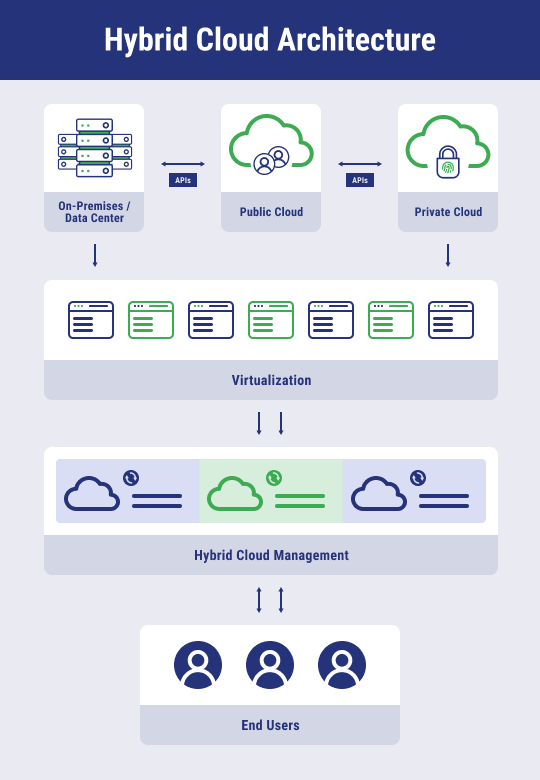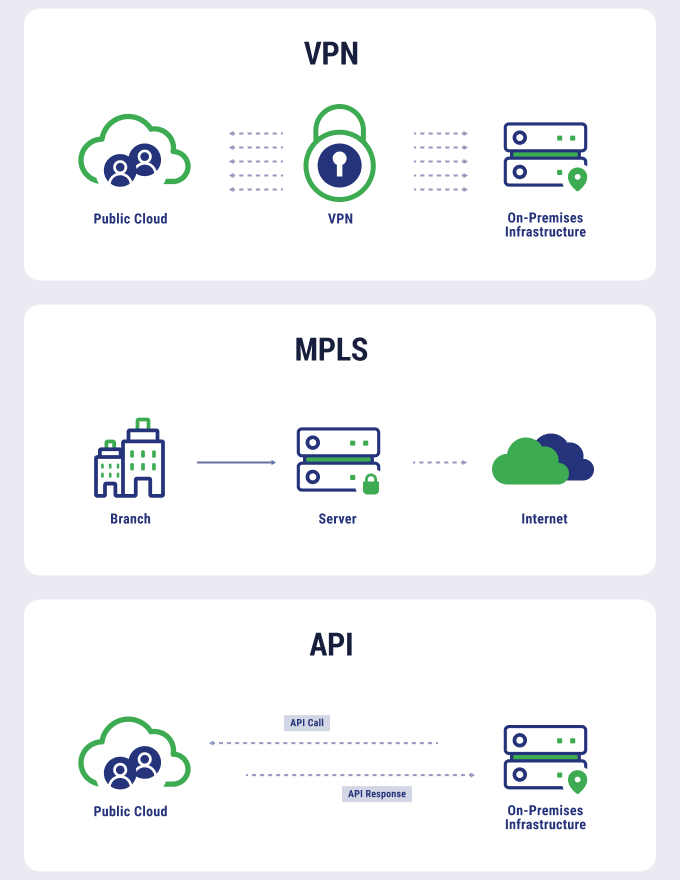
With 73% of organizations now adopting hybrid cloud solutions, it’s become necessary for businesses to not only look at the solution itself but also at the networking supporting their hybrid cloud architecture. Successful hybrid cloud networking can integrate systems, make processes more seamless, and greatly reduce latency, but it also introduces more complexity and security challenges that businesses need to address. We’ll cover what hybrid cloud networking is, its benefits for organizations, and common challenges you may face.
What is Hybrid Cloud Networking?
Hybrid cloud networking is the method of creating a connection between on-premises infrastructure and cloud resources. The goal of hybrid cloud networking is to use connectivity to harness the benefits of public, private, and on-premises environments in a way that is the most advantageous for your business. This involves not just creating connections, but also designing network topologies, setting up secure routing protocols, implementing network security measures, and ensuring consistent network policies across environments.
What is Hybrid Cloud Architecture?
Hybrid cloud architecture combines two or more cloud computing models into one IT environment with on-premises architecture. This is similar to but distinct from multicloud, which is made up of multiple public clouds. Public clouds tend to be more scalable and are available on a pay-as-you-go basis. Private clouds are more dedicated resources and can be hosted on-premises or with a managed service provider. These environments can offer more customized security.

The private part of hybrid cloud infrastructure can be hosted on-premises or at an offsite data center, including physical servers, network devices, and storage systems. When integrated into a hybrid environment, specially configured workloads can be leveraged alongside innovative cloud computing technologies.
What Are the Benefits of Hybrid Cloud Networking?
Forming this connection between the cloud and legacy frameworks can come with integration, security, flexibility, and cost benefits.
Seamless Integration
Businesses may not be ready for a full cloud migration, or the dependencies for some of their legacy workloads may be complex. A hybrid cloud strategy can bridge the gap between traditional systems and new cloud environments, allowing for greater access to resources, streamlined workflows, and better real-time collaboration without having to worry about a complete move to the cloud.
Enhanced Security
Implementing hybrid cloud networking also gives you greater control over your data, allowing you to store some information on-premises while using the cloud for less critical or sensitive data. Businesses can meet their security needs without having to move all data to the same environment.
Cost Efficiency
Choosing which environment is appropriate for which workload can also be more cost-effective. Maintaining on-premises infrastructure for fluctuating workloads can get expensive in periods where fewer resources are needed. By keeping predictable workloads in on-premises environments and prioritizing public cloud on a pay-as-you-go model for more variable needs, businesses only have to pay for what they use.
Improved Control and Flexibility
At its core, hybrid cloud networking is about bringing greater control and flexibility to your computing environment. Workloads can be deployed based on security needs, costs, and performance requirements.
No Vendor Lock-in
Adding two or more cloud environments via hybrid cloud networking can also keep a business from being limited to one cloud provider. Different cloud services can be used for their applications, decreasing the reliance on a single vendor and reducing the likelihood of vendor lock-in.
How to Improve Hybrid Cloud Performance and Optimize Workloads
Moving to a hybrid cloud model can be greatly beneficial to your business, but IT teams will need to take steps to ensure hybrid cloud performance and workloads are optimized, which can become more complicated when more environments are added.
Scalability
Scaling should happen without much intervention from the business. Use tools that can automatically scale resources in response to demands, improving access to resources in critical times without running the risk of overprovisioning. Consider which workloads need to be placed in which environments in response to how much they need to scale.
Stability
Some workloads need to be accessed at all times to maintain business operations, while others may not be as important. Architecture that is designed with stability in mind will prioritize essential workloads and provide redundancy to ensure data availability. This can include multiple points of connection, secondary sites, and more than one power source to keep downtime to a minimum even during outages.
It’s important to monitor performance after setting up the networking. IT teams should be continuously monitoring resource utilization, latency, and throughput to identify potential bottlenecks and address them quickly. Efficient routing protocols and load balancing mechanisms should be in place to manage traffic flow and distribute workloads evenly across available resources.
Functionality
Orchestration tools and APIs can make hybrid cloud networking more functional. Orchestration tools can automate workload deployment, scaling, and management across the hybrid cloud environment. This can streamline operations and cut down on manual tasks while improving performance. APIs can also be used to integrate applications and services across environments for improved data exchange and communication, two key pieces in functionality.
Additionally, effective load balancing can enhance functionality by ensuring that no single server bears too much load, thus optimizing resource use and enhancing application performance.
Data Limitations
Bandwidth caps can place a limit on data that is transferred over a network. Auto-scaling resources can help businesses avoid these data caps. Businesses should understand what their limits are in each environment and what to do to expand limitations when needed – automation and resource provisioning can significantly help with this.
Management
As you incorporate more workloads into your architecture, you’ll need a centralized, holistic view of your hybrid environment to manage it more effectively. Management tools can provide a simplified view that makes resource provisioning, monitoring, and troubleshooting more straightforward. These tools can also standardize processes across environments for security, workload deployment, and day-to-day operations, reducing the likelihood of errors and cutting down on management time.
Security
Hybrid cloud environments should be monitored for security vulnerabilities and threats, just like they should be monitored for performance. Identity and access management (IAM) controls should be implemented to limit access to sensitive resources and data, and teams should have a regular patching schedule to reduce the risk of data breaches from zero-day vulnerabilities.
How Exactly Do Hybrid Cloud Networks Connect?
Connectivity (which includes bandwidth, latency, and connection resilience) is a critical part of hybrid cloud and multi-cloud networking. Keeping a reliable and fast connection between cloud providers can help your organization meet demand and rise to the challenge that comes with increased needs for connectivity.
Technologies that may be used as part of hybrid cloud networking include virtual private networks (VPNs), multiprotocol label switching (MPLS), and application programming interfaces (APIs). Each of these tools can create connections and enable communications between environments.

Hybrid Cloud Networking Security Best Practices
In addition to identity and access management (IAM) and vulnerability patching, businesses should implement the following security best practices to protect their hybrid cloud networks:
- Encryption: Data should be encrypted in transit and at rest to be protected from unauthorized access. Manage encryption keys securely and implement strong encryption algorithms to keep data safe even if it is intercepted.
- Visibility: Cloud management tools can help you gain visibility across your hybrid network to find and eradicate risks.
- Network Segmentation: Critical workloads can be isolated from the rest of the hybrid network for greater protection. This can reduce the impact of a security breach and prevent bad actors from moving laterally.
- Firewalls: Implementing robust firewalls is essential to safeguard your hybrid cloud environment. Firewalls act as a barrier between trusted and untrusted networks, filtering traffic and blocking malicious activities. Utilize both traditional firewalls for on-premises infrastructure and cloud-native firewalls for cloud environments to ensure comprehensive protection. Configure firewall rules to restrict access based on IP addresses, protocols, and ports, and regularly update these rules to adapt to evolving threats.
- Regular Assessments: Don’t assume your security protocols are good to go. Constant monitoring can help businesses find anomalies in real-time, responding to and improving security measures accordingly.
- Training: Train employees on best practices for cybersecurity with regular educational sessions and occasional tests. For team members that fail, enroll them in additional training so they’re better able to spot incoming threats.
- Compliance: Because a hybrid cloud network brings together cloud and non-cloud resources, organizations need to ensure that their entire architecture is compliant with relevant regulatory standards for their industry and type of business. Security controls, compliance audits, and consulting with experts on hybrid cloud environments can help businesses adhere to regulations.
Challenges of Hybrid Cloud Networking
For hybrid cloud networking to be a sound decision for your business, the benefits need to outweigh the drawbacks. Consider how you will handle and overcome challenges associated with hybrid cloud, including complexity, security concerns, and performance issues before making moves.
Hybrid Cloud Complexity
A well-orchestrated hybrid cloud environment should be less complex, not more complex, but combining cloud and on-premises workloads can make it harder to streamline communications and data flow. IT professionals need to be well-versed in on-premises and cloud technologies to reduce hybrid cloud complexities, not compound them. Efficient routing and load balancing can help mitigate some of this complexity by ensuring data and workload distribution are optimized.
Security Concerns
Hybrid cloud environments offer larger potential attack surfaces for cybercriminals. IT teams need to secure data across cloud providers and with on-premises infrastructure. This can require constant monitoring, robust security tools, and consultation from hybrid security experts.
Latency Issues
Selecting the right environment for each workload can improve performance. However, businesses can experience latency issues if they haven’t chosen appropriately, or if the workloads have increased over time. Transfer to distant locations or between cloud and on-premises environments can lead to application performance dips, which is unacceptable for workloads that require real-time responses.
Integration of Legacy Systems
Integration can make business processes more efficient, but the initial setup can be challenging. Legacy systems aren’t always easy to integrate with cloud-based technologies. They can often require specialist assistance to connect, and sometimes, integration may not be worth the effort.
Cost
Organizations can take advantage of affordable solutions by being able to shop around for the best offer. However, they may not be ready for unexpected expenses that may accompany network components. It’s possible for these associated costs to increase over time. So, it’s important to consider these potential expenses down the road in addition to hybrid cloud cost benefits.
Compatibility
Coupled with complexity, IT teams need to think about the compatibility of components that may come from different vendors or belong to legacy frameworks. This is part of what can make integration so difficult, but there can also be incompatibilities between cloud environments. Gaining a strong understanding of which tools are compatible before choosing cloud providers can reduce compatibility issues.
Management
The right tools don’t fix these problems without effort. Centralized management tools can make monitoring, troubleshooting, resource allocation, and performance optimization easier, but establishing the framework takes time and expertise. Businesses need to understand the upfront investment before adding and implementing tools. For example, if you’re working with Microsoft Azure Stack, working with teams who have expertise in both Azure and Azure Stack, can make management much easier.
Power up Your Network with Hybrid Cloud Networking Experts
Understanding the benefits, best practices, and potential challenges associated with hybrid cloud networking is an important piece to building a new cloud environment that will help your business reach its goals. However, organizations may feel limited if they lack in-house hybrid cloud expertise, or simply don’t have enough time to optimize their hybrid cloud network. By partnering with experts, businesses can optimize their infrastructure and maximize their security, efficiency, and performance, making for a better internal and external user experience. Cloud networking experts know what to expect and have experienced common challenges and pitfalls, so they can help you navigate with greater ease. Unlock the full potential of your hybrid environment – start by having a conversation with TierPoint’s hybrid cloud pros today.

